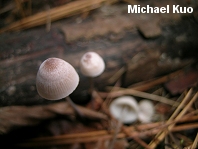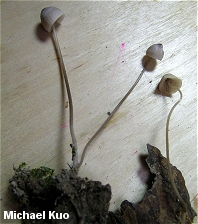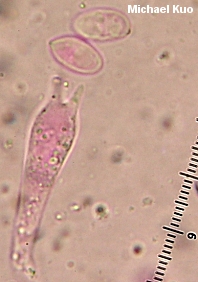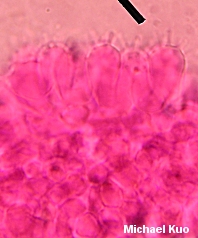| Major Groups > Gilled Mushrooms > Pale-Spored > Mycenoid Mushrooms > Mycena filopes |

|
Mycena filopes [ Basidiomycetes > Agaricales > Tricholomataceae > Mycena . . . ] by Michael Kuo This little Mycena decomposes organic litter on the forest floor, and features a very (proportionally) long stem, a hoary brownish cap, and an odor of iodine that may be strong, weak, or absent (in which case microscopic features, including the widely bag-shaped cheilocystidia that are covered with funky prickles, help to define it). As is often the case in Mycena, the name filopes is European and is questionably applied to North American mushrooms. A small army of additional names for species roughly meeting the description of Mycena filopes has marched around on both continents for over 100 years; see the discussion below if you care. Description: Ecology: Saprobic on terrestrial forest debris in both hardwood and conifer forests; usually growing gregariously but sometimes found growing scattered or even solitary; fall (or over winter in warmer climates); widely distributed, at least as a species group, in North America. Cap: Up to 2.5 cm across; conical to broadly conical, sometimes becoming bell-shaped; dry; when young with a hoary sheen, but often more or less bald at maturity; pale grayish brown, fading to grayish with a slightly darker center; the margin lined nearly to the center. Gills: Attached to the stem by a tooth; close or nearly distant; whitish or pale grayish. Stem: 5-12 cm long; 1-3 mm thick; fragile in age; equal; hollow; finely hoary at first, but soon bald; pale above and brownish to grayish below, but sometimes with faint bluish or lilac shades; basal mycelium hairy and white. Flesh: Insubstantial; pallid or grayish. Odor and Taste: Odor usually of iodine but sometimes only weakly so, or not distinctive; taste not distinctive. Spore Print: White. Microscopic Features: Spores 7-11 x 5-7 µ; weakly to moderately amyloid; elliptical; smooth. Basidia 2- or 4-spored. Cheilocystidia abundant; up to 25 x 15 µ; saccate, with numerous spine-like projections over the apex. Pleurocystidia absent. Pileipellis a cutis, with the uppermost elements diverticulate to verrucose. REFERENCES: (Bulliard, 1788) Kummer, 1871. (Fries, 1821; Saccardo, 1887; Smith, 1947 [M. iodiolens]; Moser, 1978; Breitenbach & Kränzlin, 1991; Hansen & Knudsen, 1992.) Herb. Kuo 10130903. As I am treating Mycena filopes, the names Mycena amygdalina, Mycena graveolens, and Mycena iodiolens (at a minimum) are synonyms. Various authors have separated species in this group, based on varying interpretations of archaic descriptions. In North America, Smith (1947) separated "Mycena filopes" from "Mycena iodiolens" based primarily on the presence or absence of the iodine odor. He also synonymized his own previously named species (Mycena graveolens) to the European species Mycena iodiolens. All of these names will probably have to be addressed and applied according to the rules of taxonomy when some enterprising "mycenologist" eventually conducts DNA studies of many filopes-like collections from both continents to determine what the phylogenetic species actually are. This site contains no information about the edibility or toxicity of mushrooms. |
© MushroomExpert.Com |
|
Cite this page as: Kuo, M. (2010, December). Mycena filopes. Retrieved from the MushroomExpert.Com Web site: http://www.mushroomexpert.com/mycena_filopes.html |



